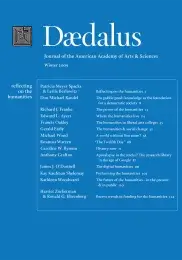The future of the humanities - in the present & in public
Since the mid-twentieth century, the professionalization of our disciplines has been a hallmark of higher education in general and the research university in particular. Despite the repeated calls over the past twenty-five years for a renewal of the civic mission of higher education,1 professionalization continues to hold tenacious sway and is largely understood to contradict the purposes and practices of public scholarship, which, in turn, is dismissed under the demoralizing rubric of service or the paternalistic rubric of outreach. It is only too clear that “there has been a weakening of the informal compact between the university and society,” as the historian Thomas Bender points out in his invaluable essay on the American university from 1945 to 1995.2 If some twenty years ago it could be asserted in the Report from the National Task Force on Scholarship and the Public Humanities that the humanities “are valuable for their own sake and the nation must support and sustain scholarship because that enriches the common fund of knowledge,”3 today the notion of the intrinsic good of the humanities is definitely not a part of what is generally referred to as “making the case” for the humanities.
What is public scholarship? In suggesting an answer to this question, I turn to the influential work of Imagining America: Artists and Scholars in Public Life, a national consortium established at the University of Michigan in 2001 that numbers over eighty institutions across the United States representing the full spectrum of higher education, from community colleges and colleges of arts and design to research universities and liberal arts colleges.1 Now based at Syracuse University, Imagining America is devoted to expanding the place of public scholarship in the humanities, arts, and design in higher education in the conviction that it serves a democratic purpose. Scholarship in Public, its groundbreaking report on the importance of including public scholarship in considerations of promotion and tenure, was released in May 2008. Authored by Julie Ellison and Timothy K. Eatman, the report offers a definition–necessarily abstract and general–of what is referred to as publicly engaged academic work. Public scholarship, the report argues, is integral to the academic area of a faculty member’s research or creative activity. It includes “different forms of making knowledge ‘about, for, and with’ diverse publics and communities,” and “it contributes to the public good and yields artifacts of public and intellectual value.”2 As the report notes, public scholarship exists on a continuum with traditional scholarship and often takes the form of projects that combine research, teaching, and creative activity as well as publication. Recommended is the use of a portfolio in the tenure dossier that might include writing for a non-academic audience, policy reports, and oral histories. Not all work in the public humanities would be considered public humanities scholarship. . . .
